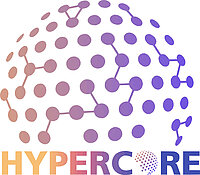

Sustainable communication for the hyper-connected networks of the future
In the HYPERCORE project, coordinated by the Fraunhofer Heinrich Hertz Institute (HHI), we are developing a future-proof communication infrastructure for the hyper-connected society. This infrastructure is characterized by increased network capacity, flexibility, and security while maintaining minimal energy consumption.
Funded by the Federal Ministry of Education and Research (BMBF)
Duration: July 2024 - June 2027
As part of HYPERCORE, we focus on optimizing metro and core networks, which will serve as the foundation for the digitally connected society of tomorrow. Here, we employ an innovative approach that combines all three physical dimensions - time, frequency, and space - to enhance transmission capacity and develop new, energy-efficient networking solutions.
The project’s concept relies on four core technologies:
-
Multiband transmission systems and energy-efficient multiband transceivers – These technologies expand the wavelength range and enable significantly increased data transmission capacity.
-
Coherent OTDR (Optical Time-Domain Reflectometry) system – Through machine learning, we automate network management while improving the monitoring and maintenance of fiber optic infrastructure.
-
Digital Twin technology for optical communication networks – The use of digital twins allows us to simulate network configurations and maximize efficiency before implementation in the real world.
-
Energy-efficient signal processing – Innovative algorithms reduce energy consumption, thereby contributing to a lower carbon footprint.
To validate the practical applicability of the developed technologies, field tests are scheduled to begin in spring 2026 in the Kiel and Berlin regions. For these tests, the Christian-Albrechts-University in Kiel, in cooperation with Stadtwerke Kiel, will provide a designated fiber optic network, where the coherent OTDR systems will be tested. These systems will not only facilitate data transmission but will also be able to detect additional information, such as movements and vibrations near the fiber optic cables.
In Berlin, the focus will be on testing novel transmitters and receivers in the O-band, as well as energy-efficient algorithms for data-intensive applications, such as 8K video conferencing.
The project aims to combine network security and energy efficiency, making a significant contribution to the protection of critical infrastructures and reducing the carbon footprint of digital applications. In addition to Fraunhofer HHI, renowned research institutes and universities such as the University of the Bundeswehr Munich, Karlsruhe Institute of Technology, Christian-Albrechts-University Kiel, and the University of Stuttgart are involved. Industry partners such as Adtran, VPIphotonics, ADDIX, and CAD connect are supporting the swift implementation of the results.